All About Crochet Hooks: A Beginner’s Guide
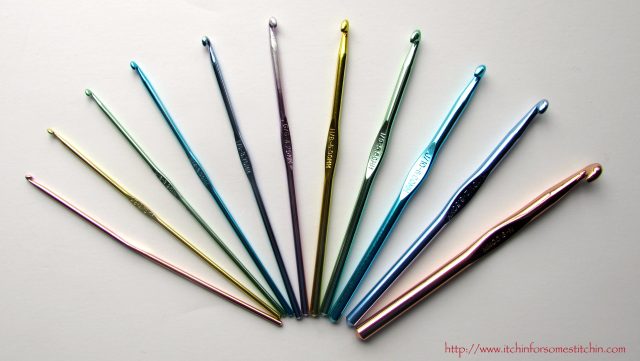
Hi folks! Today I want to talk about something super important. Hooks. Yes, I said hooks. Now, this may not seem like a big deal for someone whose been crocheting for years, but for all you crochet newbies out there, learning about hooks is critical.
I can remember when I started crocheting. I went to JoAnn’s and simply stared at all the hooks. There were so many! Fat ones, skinny ones, metal ones, plastic ones, colored ones, even ones that light up. I had no idea which one to pick and no one to guide me. If you’ve been there or you don’t want to be there, then listen up, you’ll want to pay attention to this post.
The Anatomy of a Crochet Hook
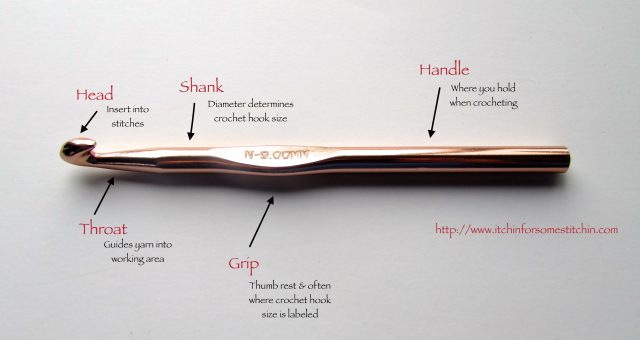
You probably know that a hook is the main tool you will use when crocheting. Although all hooks serve the same function, they are not all the same.
So, let’s go over the anatomy of a crochet hook. Knowing a hook’s structure is not essential to your ability to crochet. However, when you understand the tools of your trade or hobby, it makes you better at your craft because you will use the tool more efficiently and effectively.
Head
Sometimes called the “hook” or “point”, the head is used to catch the yarn and thread. It is also the part that goes into the stitch and pulls the yarn through the stitch.
Hooks can either be Inline or Tapered. An inline hook means that the head and throat areas of the hook are in line with the rest of the hook. An example of inline hooks are those manufactured by Susan Bates. A tapered hook means that the throat of the hook is narrow or tapered so that the head is not inline with the rest of the hook. Hooks manufactured by Boyes are a good example of tapered hooks.
Although some crocheters don’t notice a difference between the two hook types, others often have strong opinions about their preference and will only use a particular type. I own and use both types, but I tend to prefer Boyes. In my opinion, the tapered throat just seems to let the yarn move more smoothly, thus making each stitch easier to crochet.
Just, fyi, I have yet to find a pattern that specifies which hook type you must use. Whether you use an inline or tapered hook is really your personal preference. Be sure to experiment with both types to decide which one is most suitable to you.
Throat
The throat is the shaped section right below the head that guides the yarn or thread up into the working area. This area is what catches your yarn as your pull it through the loop. If you find that you are getting snags or splitting the yarn as you crochet, then you might want to try a hook with a tapered throat (Boyes). However, if you tend to drop loops or your hook seems to pop out of the stitches a lot, you should try the inline hooks (Bates).
Shaft
The Shaft is also called the “shank” and is the section that determines hook size. For example, if you are using a J-10/6.00mm hook that means that the shaft of the hook has a diameter of 6.00mm. The diameter of the shaft determines the size of your finished stitch. The larger the diameter of the hook means the larger your finished stitch will be. A smaller shaft diameter means a smaller finished stitch.
Grip
The Grip is also called the Thumb Rest. This is the section intended for gripping the hook with your thumb and index or middle finger. It is where crochet hook sized is labeled.
Handle
This is the end that you hold while crocheting. Handles can be long or short. You should choose the one that suits your preference. Generally, the handle is same size as the rest of the hook. These work great for most crocheters. However, if you suffer from arthritis, stiffness, pain, or weakness in your hands, wrists or arms, I would recommend crochet hooks with ergonomic handles. These handles are larger than the rest of the hook.
What Are Crochet Hooks Made From?
Crochet hooks are made from an array of materials. The material from which a crochet hook is made doesn’t usually affect the size of your finished product, but for some people it does affect the enjoyment of the crocheting process. While a hook made from metal may feel fine to you, it may be uncomfortable for someone else.
Plus, a hook made of a particular material may work well with a specific brand or weight of yarn, but not for others. This is something to keep in mind if you are having issues with yarn snagging or not moving smoothly on your hook. Try a hook made from a different material to see if it helps.
Hooks are commonly made from various types of wood, plastic, steel, brass, gold, silver, and aluminum. Some hooks may also have a handle made of different material than the rest of the hook, such as rubber, clay, or wood. Hooks made from plastic, aluminum, steel, and wood can usually be found in most craft stores. Speciality hooks made from higher grade materials may have to be special ordered. The difference in material may greatly affect the price of the hook.
Steel
These are your super small crochet hooks ranging from 04.-3.35mm (00 to 16 in US sizing) and they are used for crocheting with thread yarn. Thread yarn is typically used for making fine crochet projects, such as jewelry, doilies, and lace.

Aluminum
These come in sizes 2.5-19mm (B to S in US sizing). These are very durable and easy to find, but many people do not enjoy using them. Some people complain that they are too cold, heavy, or cumbersome. These can be particularly difficult issues for someone with arthritis or other hand conditions.

Plastic
These are also available in sizes 2.5-19mm (B to S in US sizing). These are generally very inexpensive and are often preferred by people with hand pain due to their flexible nature. However, these tend to break easily.

Wood
I’ve seen crochet hooks made from bamboo, rosewood, birch, and walnut, but they can be made from almost any type of wood. These hooks come in sizes 2.5-19mm (B to S in US sizing) and are often very pretty. They are also warm so they are easier for people with hand issues, but they can be a bit more costly than the aluminum or plastic hooks.

Note: This hook is technically a hybrid, despite the fact that it was labeled only as a bamboo hook when I purchased it.
Hybrid
These crochet hooks can be of any size. Generally the head, throat, and shaft are made from one material, such as aluminum. While the grip and handle are made of another type of material, such as clay or rubber. Ergonomic crochet hooks are hybrids that are usually aluminum and rubber.
Artisan-made
Although much of these are made of hand-turned woods, some decorated with beads or semi-precious stones, they can actually be made from anything the crafter desires. I’ve even seen a set of Alice In Wonderland themed hooks. Even you can be the artisan! There are multiple DIY tutorials on Pinterest for making your own crochet hooks or handles.
Here are just a few if you want to give it a try.
Oh and by the way, if you are interested in the Alice In Wonderland hooks or some other really cool hooks check out HookEwe. I do not know the shop owner and cannot speak for the utility of the hooks, but I sure think they look amazing!
Crochet Hook Sizes and Conversions
Hooks come in an array of sizes. The size of a crochet hook is determined by the diameter of its shaft, using the metric system. This can be determined by using a hook gauge. Unfortunately, there doesn’t seem to be a standard naming system for these measurements as the hooks are labeled different in the US versus the UK.
In the US naming system, the further the letter is in the alphabet the larger the hook size (mm). This is reverse for the UK system where the larger the number then the smaller the hook size (mm).
To make it even more complicated, when using steel hooks, which are typically used when crocheting with thread, the two systems are again reversed. In the US system, the smaller the hook size (mm), the larger the number. In the UK system, the smaller the hook size (mm), the smaller the number.
Crazy, right? Here’s some handy charts to make it easier.
Picking The Right Hook
Alright, so now you understand your main crochet tool, the hook, better. You know what hooks can be made from, you know their sizes, and 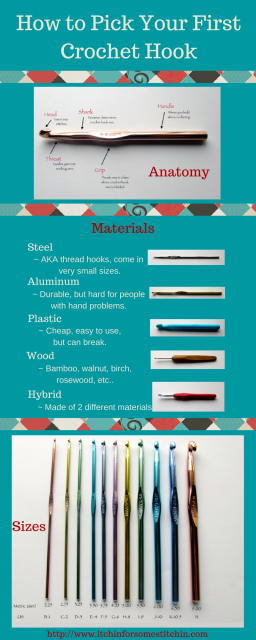 you know how to convert among the metric, US, and UK sizing systems. But… you are probably still wondering on how earth to pick one to start with. Well, you are going to hate the answer.
you know how to convert among the metric, US, and UK sizing systems. But… you are probably still wondering on how earth to pick one to start with. Well, you are going to hate the answer.
The answer is: It depends. Ugh…
It depends on where you are in your crochet journey. If you are advanced enough to use a pattern, then use the hook specified in the pattern. However, if you are an absolute crochet beginner and are still learning basic stitches I would suggest starting with a 10mm (US N-15) hook. This is because using a larger hook is easier than using a smaller one when first learning how to crochet.
If you would like some more tips, check out The 10 Best Crochet Tips for Absolute Beginners.
Now, whether you choose metal, plastic, wood, etc… is entirely up to you. I would suggest starting with aluminum or plastic at first simply because they are budget friendly and easy to find.
The final question is should you pick a tapered or inline hook? I would buy one of each. You have to try them both to find out which one you prefer. If you take my suggestions and buy both hooks made either of aluminum or plastic, it should cost about $5 or less.
When I was a crochet beginner, I didn’t know what to buy. So, I bought a set of tapered aluminum crochet hooks for about $30. Luckily, these hooks work just fine for me. But that may not be the case for you so don’t follow in my footsteps. I’d hate for you to buy an entire set of hooks only to find out that you don’t like them. Start small and cheap. Determine your hook preference. Then buy a set if you choose.
Have You Found Your Favorite Hook?
Until next time… Happy Crocheting!


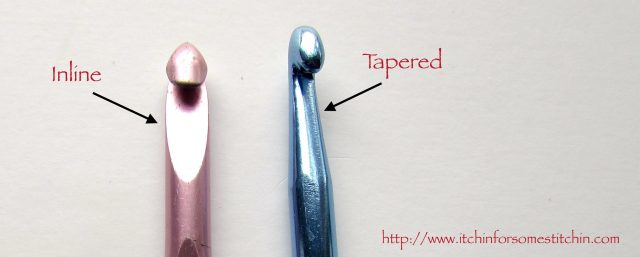
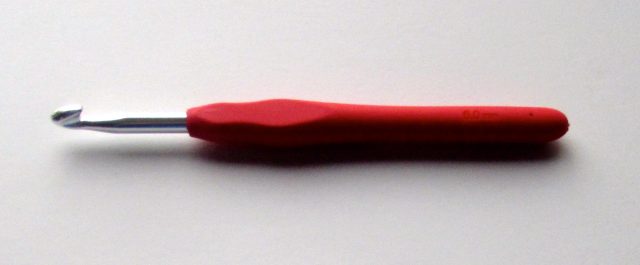
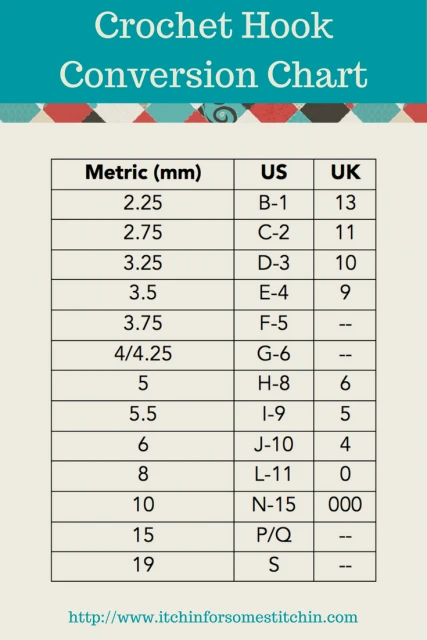
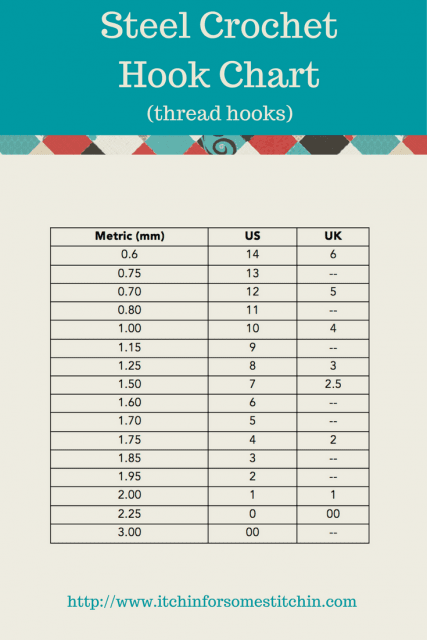
Katherine Matthews
Tuesday 6th of April 2021
My daughter showed me this article and I appreciate the information very much!
Itchin4Stitchin
Wednesday 7th of April 2021
Hi Katherine,
You are so very welcome! Please feel free to contact me if you have any questions as you get started on your crochet journey - I am happy to help!
Best,
RaeLynn
How to Crochet a Foundation Chain - Itchin' for some Stitchin'
Tuesday 25th of June 2019
[…] In the above picture, it is right where my foundation chain is attached to the hook. To review the anatomy of a crochet hook see: How to Pick Your First Crochet Hook. […]